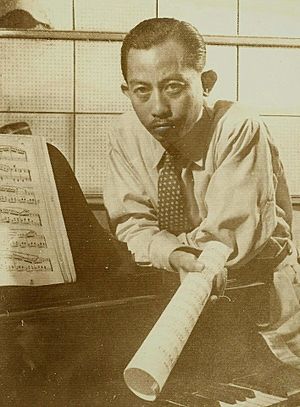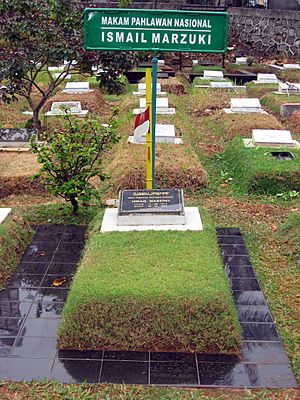Ismail Marzuki facts for kids
Quick facts for kids
Ismail Marzuki
|
|
|---|---|

Ismail Marzuki, unknown year
|
|
| Background information | |
| Born | 11 May 1914 Batavia, Dutch East Indies |
| Died | 25 May 1958 (aged 44) Jakarta, Indonesia |
| Occupation(s) | Composer, songwriter |
| Years active | 1931–1958 |
Ismail Marzuki (also known as Bang Ma'ing) was a famous Indonesian composer and songwriter. He lived from May 11, 1914, to May 25, 1958. During his life, he wrote over 200 songs. Many of these were popular patriotic songs.
Some of his most well-known songs are "Halo, Halo Bandung", "Gugur Bunga", and "Rayuan Pulau Kelapa". He is so important that a cultural center in Jakarta, called Taman Ismail Marzuki, was named after him in 1968. In 2004, he was officially named one of the National Heroes of Indonesia.
Contents
His Life Story
Ismail Marzuki was born in Kwitang, Jakarta. At that time, Jakarta was known as Batavia. He came from a rich Betawi family. His father, Marzuki, owned a car repair shop. He also played a traditional drum called the rebana. Ismail's mother passed away when he was born.
From a young age, Ismail loved music. He would listen to songs again and again on his family's gramophone. He taught himself to play the rebana, ukulele, and guitar.
His Education
Ismail went to an elementary school for Indonesian children called HIS. Later, he attended a Dutch-language middle school called MULO. He became very good at speaking Indonesian, English, and Dutch. He also studied religion. Even though he loved music, he never took formal music lessons. He learned everything by himself.
His Music Career
In 1931, Ismail wrote his first song, "O Sarinah". This song was about people who were suffering. Over his career, he wrote between 202 and 204 songs.
Some of his most famous songs include:
- "Halo, Halo Bandung"
- "Rayuan Pulau Kelapa" (written in 1944, meaning Solace on Coconut Island)
- "Gugur Bunga di Taman Bakti" (written in 1945, meaning The Fallen Flower in Bakti Garden)
- "Selendang Sutera" (written in 1946, meaning A Coil of Silk)

Ismail Marzuki started his music career in the mid-1930s. He joined an orchestra called Lief Java. With this group, he often performed on the radio. Later, he led other orchestras, including the Jakarta Studio Orchestra.
He wrote his last song, "Inikah Bahagia" (Is This Happiness), in 1957. Ismail Marzuki passed away on May 25, 1958, at his home in Tanah Abang, Jakarta. He is buried in Karet Bivak Cemetery.
What Was His Music Like?
Ismail Marzuki's songs are full of love for Indonesia. They show a strong spirit of unity and harmony. His songs are easy to remember because they have simple words and tunes. The melodies are usually in a middle range, which makes them easy for everyone to sing.
His Life Outside Music
In 1940, Ismail Marzuki married Eulis Zuraidah. She was a Sundanese keroncong singer from Bandung. His wife inspired him to write a Sundanese song called "Panon Hideung". This song is the Sundanese version of "Dark Eyes". "Panon Hideung" means "Black Eyes".
Ismail loved collecting musical instruments. He had guitars, mandolins, flutes, clarinets, saxophones, accordions, and a piano.
He was very nationalistic. This means he loved his country deeply. During the Indonesian National Revolution, he even sold a traditional dish called gado-gado with his wife. He did this instead of working with the Dutch-Allied government. He also had a romantic side. He wrote love songs like "Kalau Anggrek Berbunga" (When the Orchid Blossoms) and "Siasat Asmara" (Love's Tactics).
Why He's Remembered
People have called Ismail Marzuki a "genius" and a "legendary" musician. They say he had a great natural talent for music. Besides playing many instruments, he was also known as a singer. He had a deep voice, which earned him the nickname "Bing Crosby from Kwitang" from his friends.
Many of Ismail Marzuki's songs have been recorded again by other artists. They have been sung in different styles, like pop music and keroncong. Some of his songs, such as "Halo, Halo Bandung" and "Rayuan Pulau Kelapa", are very important. They are even taught in schools across Indonesia.
A classical composer named Ananda Sukarlan has created special piano and orchestra music based on Ismail's songs.
Ismail Marzuki received the first Wijaya Kusuma award from President Suharto in 1961. After he passed away, the Taman Ismail Marzuki cultural center was opened in 1968 to honor him. In November 2004, he was officially recognized as a National Hero of Indonesia. This was announced by President Susilo Bambang Yudhoyono.
Famous Songs He Wrote
- Aryati
- Bandaneira
- Bandung Selatan di Waktu Malam (1948)
- Beta dan Ayunda
- Gagah Perwira (1944)
- Gita Malam
- Gugur Bunga
- Halo Halo Bandung
- Indonesia Pusaka (1940)
- Inikah Bahagia
- Jangan Ditanya
- Jauh di Mata Di Hati Jangan
- Juwita Malam
- Kalau Anggrek Berbunga
- Karangan Bunga dari Selatan
- Kasim Baba
- Kasih Putus di Tengah Jalan
- Keroncong Serenata
- Lenggang Bandung
- Melati di Tapal Batas (1947)
- O Angin Sampaikan Salamku
- O Kopral Jono
- O Sarinah (1931)
- Panon Hideung (1931)
- Patah Cincin
- Rayuan Pulau Kelapa
- Rindu Lukisan
- Roselani
- Sabda Alam
- Sampul Surat (1943)
- Saputangan dari Bandung Selatan
- Sejuta Bintang
- Selamat Datang Pahlawan Muda (1949)
- Selendang Sutra
- Sepasang Mata Bola (1946)
- Setangkai Bunga Mawar (1943)
- Siasat Asmara
- Sumbangsihku (1946)
- Wanita
See also
 In Spanish: Ismail Marzuki para niños
In Spanish: Ismail Marzuki para niños


